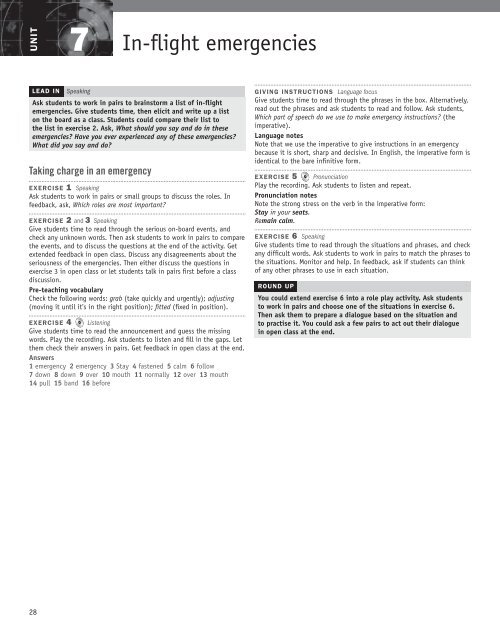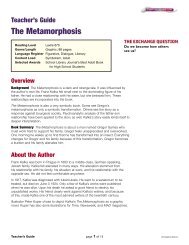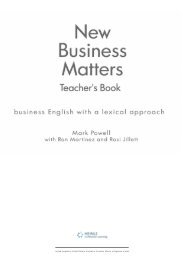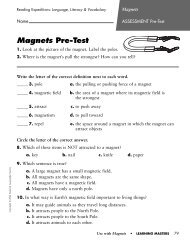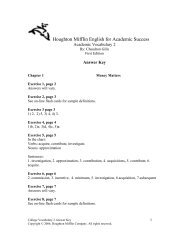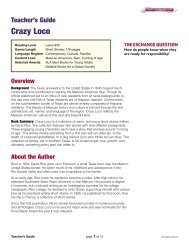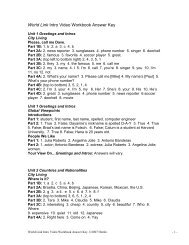English for Cabin Crew Trainer's Guide - Heinle
English for Cabin Crew Trainer's Guide - Heinle
English for Cabin Crew Trainer's Guide - Heinle
Create successful ePaper yourself
Turn your PDF publications into a flip-book with our unique Google optimized e-Paper software.
UNIT<br />
7 In-fl ight emergencies<br />
LEAD IN Speaking<br />
Ask students to work in pairs to brainstorm a list of in-fl ight<br />
emergencies. Give students time, then elicit and write up a list<br />
on the board as a class. Students could compare their list to<br />
the list in exercise 2. Ask, What should you say and do in these<br />
emergencies? Have you ever experienced any of these emergencies?<br />
What did you say and do?<br />
Taking charge in an emergency<br />
EXERCISE 1 Speaking<br />
Ask students to work in pairs or small groups to discuss the roles. In<br />
feedback, ask, Which roles are most important?<br />
EXERCISE 2 and 3 Speaking<br />
Give students time to read through the serious on-board events, and<br />
check any unknown words. Then ask students to work in pairs to compare<br />
the events, and to discuss the questions at the end of the activity. Get<br />
extended feedback in open class. Discuss any disagreements about the<br />
seriousness of the emergencies. Then either discuss the questions in<br />
exercise 3 in open class or let students talk in pairs fi rst be<strong>for</strong>e a class<br />
discussion.<br />
Pre-teaching vocabulary<br />
Check the following words: grab (take quickly and urgently); adjusting<br />
(moving it until it’s in the right position); fi tted (fi xed in position).<br />
EXERCISE 4 Listening<br />
Give students time to read the announcement and guess the missing<br />
words. Play the recording. Ask students to listen and fi ll in the gaps. Let<br />
them check their answers in pairs. Get feedback in open class at the end.<br />
Answers<br />
1 emergency 2 emergency 3 Stay 4 fastened 5 calm 6 follow<br />
7 down 8 down 9 over 10 mouth 11 normally 12 over 13 mouth<br />
14 pull 15 band 16 be<strong>for</strong>e<br />
28<br />
GIVING INSTRUCTIONS Language focus<br />
Give students time to read through the phrases in the box. Alternatively,<br />
read out the phrases and ask students to read and follow. Ask students,<br />
Which part of speech do we use to make emergency instructions? (the<br />
imperative).<br />
Language notes<br />
Note that we use the imperative to give instructions in an emergency<br />
because it is short, sharp and decisive. In <strong>English</strong>, the imperative <strong>for</strong>m is<br />
identical to the bare infi nitive <strong>for</strong>m.<br />
EXERCISE 5 Pronunciation<br />
Play the recording. Ask students to listen and repeat.<br />
Pronunciation notes<br />
Note the strong stress on the verb in the imperative <strong>for</strong>m:<br />
Stay in your seats.<br />
Remain calm.<br />
EXERCISE 6 Speaking<br />
Give students time to read through the situations and phrases, and check<br />
any diffi cult words. Ask students to work in pairs to match the phrases to<br />
the situations. Monitor and help. In feedback, ask if students can think<br />
of any other phrases to use in each situation.<br />
ROUND UP<br />
You could extend exercise 6 into a role play activity. Ask students<br />
to work in pairs and choose one of the situations in exercise 6.<br />
Then ask them to prepare a dialogue based on the situation and<br />
to practise it. You could ask a few pairs to act out their dialogue<br />
in open class at the end.


